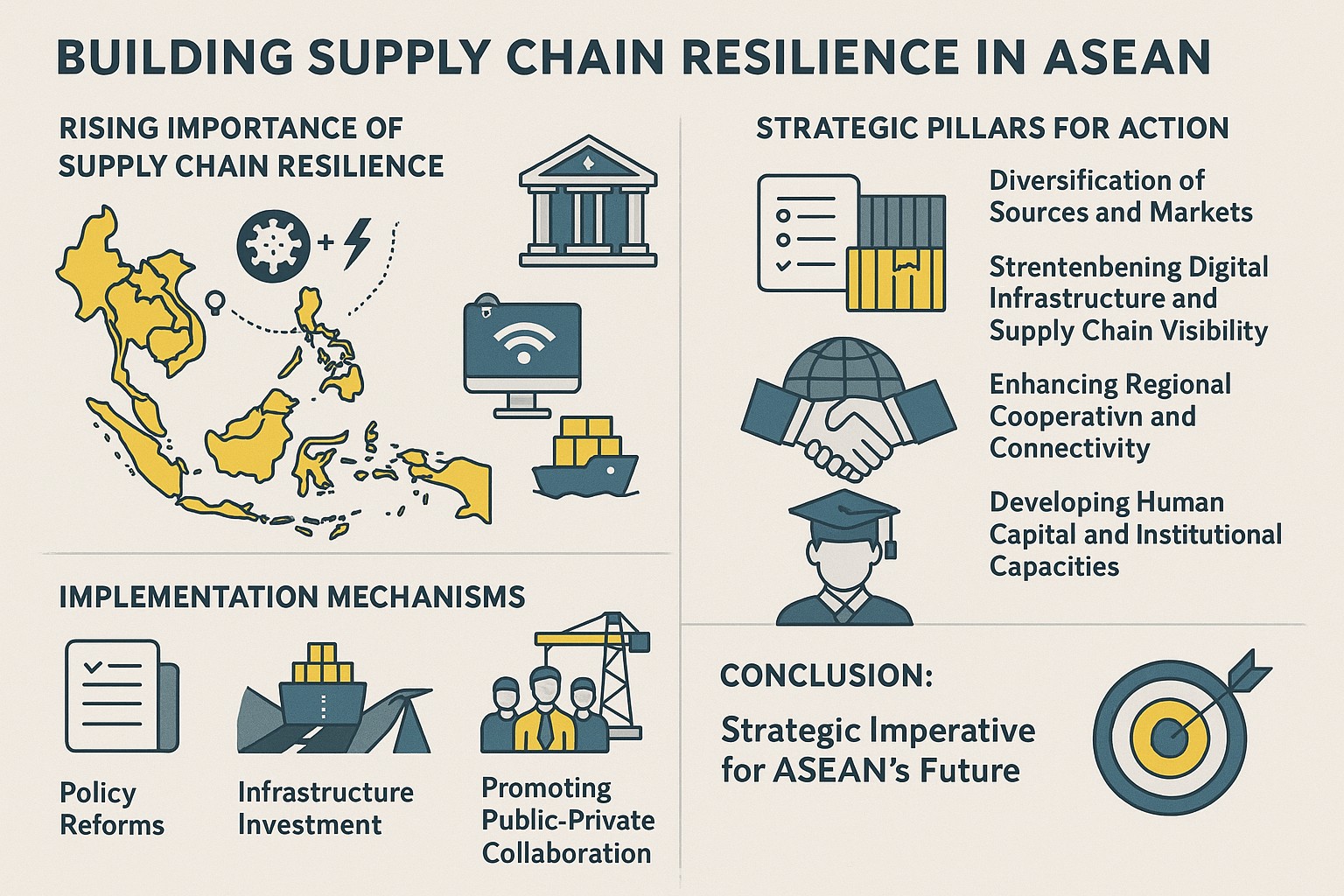
The Asian Development Bank (ADB), in its report Building Supply Chain Resilience in ASEAN, presents a detailed strategy for how ASEAN economies can fortify their supply chains in an increasingly volatile global environment. Recognizing the significant disruptions caused by COVID-19, geopolitical tensions, technological shifts, and climate change, the document stresses the urgent need for diversified, digitalized, and coordinated supply chain systems.
Key Insights and Extended Highlights
1. Rising Importance of Supply Chain Resilience
The report highlights that ASEAN’s economic prosperity is deeply tied to open, efficient, and stable supply chains. The region’s reliance on global value chains (GVCs) exposes it to external shocks, which can cause significant disruptions. Hence, building resilience is now as important as improving efficiency.
The ADB defines supply chain resilience as the ability to prepare for, respond to, and recover quickly from disruptions, ensuring continuity and competitiveness.
2. Strategic Pillars for Action
ADB recommends a comprehensive approach built on several key pillars:
- Diversification of Sources and Markets. ASEAN countries must diversify their supplier bases and target new markets to avoid overconcentration in any single country or sector. This requires proactive trade agreements, market intelligence gathering, and promotion of alternative sourcing strategies.
- Strengthening Digital Infrastructure and Supply Chain Visibility. Building robust digital platforms to monitor supply chains in real-time is essential. Technologies like blockchain, IoT (Internet of Things), and AI (Artificial Intelligence) can greatly enhance traceability, efficiency, and risk management.
- Enhancing Regional Cooperation and Connectivity. ASEAN countries should further integrate logistics systems, harmonize regulatory standards, and promote cross-border data sharing. Regional frameworks like ASEAN Single Window and Master Plan on ASEAN Connectivity 2025 are critical tools in this effort.
- Developing Human Capital and Institutional Capacities. A resilient supply chain needs a skilled workforce. Governments must invest in education, vocational training, and institutional reforms to prepare human resources for a tech-driven supply chain environment.
3. Implementation Mechanisms
The report proposes specific action steps for implementing the strategy:
- Policy Reforms. Governments must enact supportive policies including trade facilitation reforms, investment incentives for digital technology adoption, and environmental sustainability standards.
- Infrastructure Investment. There is a strong need to upgrade physical infrastructure (ports, roads, logistics hubs) and digital infrastructure (5G networks, cloud computing facilities) to support the seamless movement of goods, services, and information.
- Promoting Public-Private Collaboration. ADB stresses that public-private partnerships (PPPs) are crucial for innovation, financing, and operational expertise. Governments must create enabling environments for businesses to invest and collaborate in strengthening supply chains.
- Risk Assessment and Early Warning Systems. ASEAN economies must establish supply chain risk monitoring systems that provide early warnings for disruptions, allowing for proactive responses instead of reactive measures.
4. Regional and Global Dimensions
The report also highlights that ASEAN’s efforts to strengthen supply chain resilience must be aligned with:
- Global trade rules under the World Trade Organization (WTO).
- Regional trade agreements such as the Regional Comprehensive Economic Partnership (RCEP).
- Sustainability goals like carbon-neutral logistics and ESG (Environmental, Social, and Governance) compliance.
ASEAN’s collective efforts will determine whether it can maintain its global competitiveness and avoid being marginalized amid emerging regionalization trends.
Conclusion: Strategic Imperative for ASEAN’s Future
The ADB’s report delivers a clear, actionable roadmap for ASEAN policymakers, businesses, and development partners. Building resilient supply chains is not just about mitigating risks; it is about creating new growth opportunities, enhancing regional integration, and positioning ASEAN as a trusted node in global value chains.
By investing in digital transformation, regional cooperation, infrastructure upgrades, and human capital development, ASEAN can future-proof its economies against the next wave of global challenges.
Summary by DigitalTrade4.EU
